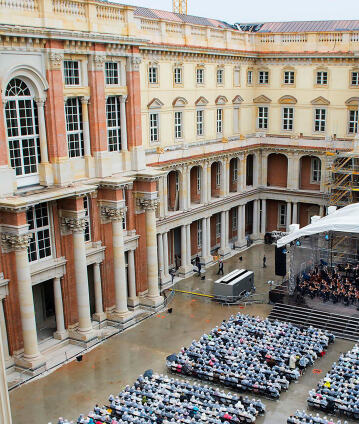Kirill Petrenko conducts Beethoven and Strauss at the Berlin Palace

A special concert at a special location: the Berliner Philharmoniker and Kirill Petrenko, their chief conductor designate, perform Beethoven’s Seventh Symphony and tone poems by Richard Strauss in the reconstructed Berlin Palace. The building, which was badly damaged during the Second World War and demolished in 1950, does not reopen until 2019, so this open-air concert in the splendid Baroque Schlüterhof allows us a first glimpse.
At noon on 9 November 1918, the Social Democrat Philipp Scheidemann proclaimed the German Republic from the balcony of the Reichstag. The second declaration, by Karl Liebknecht, followed two hours later – opposite the main entrance of the Berlin Palace where a lively crowd had gathered. “Liebknecht announced,” wrote the Vossische Zeitung on 10 November1918, “that the Workers’ and Soldiers’ Council had taken over the Palace.” From then on, the approximately 1,200 rooms of the Hohenzollern residence which had become the “Palace of the Republic” served as offices for state representation and administration, and as early as 1920, the decision was made to house the Kunstgewerbemuseum, the decorative arts museum, there. However, the Palace was also an office block, and it increasingly became a centre for scholarship: it soon housed the German Research Foundation, the Kaiser Wilhelm Society for the Advancement of Science, the German Academic Exchange Service which was founded in response to the First World War, plus the Alexander von Humboldt Foundation (from 1925). The psychology institute of the university which was suffering from lack of space also found a new home here, as did the sound archive founded as the Berliner Phonogramm-Archiv, set up on the initiative of music psychologist Carl Stumpf: today’s idea of the “Humboldt Forum” as a centre of knowledge seems to have been a reality even then. In the mid-1920s, the German Art Society was among the new tenants who attempted to do something about the economic plight of visual artists – hardly anyone had the money to buy prints, pictures or sculptures.
Music also found its place: from May 1932, the “Schlossmusiken” were launched, which took place in the open air in the Schlüterhof: Erich Kleiber opened it together with the Kapelle der Staatsoper Unter den Linden. Shortly after, he also conducted the Berliner Philharmoniker at this historic venue for the first time. Following the orchestra’s first open-air concert at the Kulturforum on the day after the season opening in 2016, this year it will take place in the reconstructed Schlüterhof – the centre of the newly-built Humboldt Forum, which will host permanent exhibitions from 2019 onwards, including those of the Ethnological Museum and the Museum of Asian Art (Stiftung Preußischer Kulturbesitz - Staatliche Museen zu Berlin), the Berlin Exhibition (Kulturprojekte Berlin und Stadtmuseum Berlin) and the Humboldt Labor (Humboldt-Universität zu Berlin). The conductor will be Kirill Petrenko, who has programmed Beethoven’s Seventh Symphony plus Richard Strauss’s Don Juan and Tod und Verklärung.
© 2018 RBB
Artists
Our recommendations
- Kirill Petrenko conducts Scriabin, Stravinsky and Stephan
- Kirill Petrenko conducts Strauss’s “The Woman without a Shadow”
- Kirill Petrenko conducts Tchaikovsky and two world premieres
- Kirill Petrenko and Lisa Batiashvili
- Kirill Petrenko conducts Beethoven, Brahms and Schoenberg
- The Berlin Phil Series: Kirill Petrenko live – Serenades